Yes, it is possible to put a baby car seat on a motorcycle. There’s no disputing that motorcycling is a fun and exciting pastime, but it comes with many risks. Motorcycles are inherently more dangerous than cars because the rider is exposed to injury from the weather, natural elements, and even other vehicles on the road.
Despite these risks, millions of people worldwide cycle every day for work or recreation. That’s why we are here to answer one important question: Can you put a car seat on a motorcycle?
Can You Put A Car Seat On A Motorcycle?
If you plan, it is possible to take a young child on a motorcycle ride. You can secure certain car seats in a sidecar or affix them to the passenger seat.
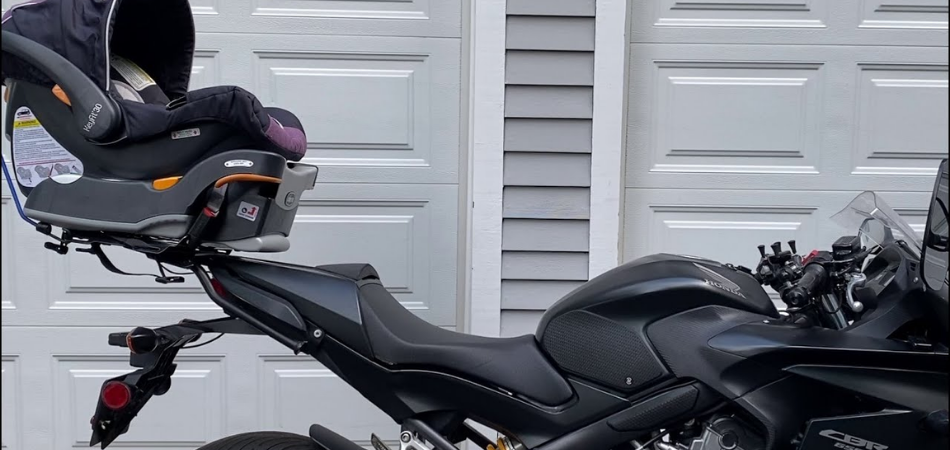
All motorcycles should have safety equipment such as helmets, and if you are going to ride with your child, you should know the dangers and take the proper safeguards. Unfortunately, many people do not consider this before allowing their children to ride with them on their bikes. It’s great to get a comfortable car seat for your motorcycle. For example, a comfortable seat for Heritage Softail Classic can easily be gotten for your Harley-Davidson motorcycle.
Dangers And Benefits Of Putting a Car Seat On a Motorcycle
Motorcycle safety is a much-deliberated subject. But many riders are not sure whether or not to put their infants on the backseat of their motorcycle for that dangerous trip. One of the first considerations that people have is whether they can actually do this and if they can, what is the safest way to do it?
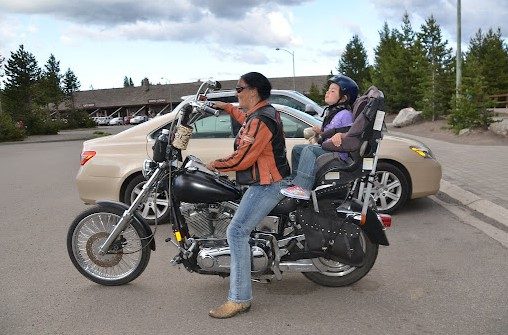
Do you ride a motorcycle and have children? Or perhaps this is something you have wanted to do for some time. Learn about the benefits and dangers of putting a car seat on a motorcycle, here!
Advantages:
- Car seats are a necessity for parents concerned about the safety of their young children while travelling on a motorcycle.
- Car seats keep children restrained and make it easier for drivers to concentrate on the road rather than focusing attention on worrying about their children’s motion.
- Riding a motorcycle with your child can be a fun and educational experience.
- Children’s car seats, available for motorcycles and cars, make it easier and faster to do everyday duties and journeys, so instead of worrying for your lone kid at home, they may accompany you on your journey.
Disadvantages:
- Riding a motorcycle with children in a car seat can be dangerous since such seats are meant only for cars, vans, or trucks.
- They do not afford the same level of protection as regular motorcycle helmets, and they may not follow the same safety requirements.
- Even if you’re certain that you’ve secured your child’s car seat properly, it can still fly away in the event of a sudden collision. (Better for a reader to see this notice in a few words than to have to figure it out from the picture!)
- Even if your child is buckled into a car seat, they probably can not fit into a bike helmet. In the event of an accident, a helmet that is too large will not provide adequate protection, and a heavy helmet can injure your child’s head and neck. A long motorbike trip can make a newborn restless and irritable because of the vibration and jostling.
- The vibrations and jostling of a motorcycle trip can harm an infant’s head and neck.
If You Still Insist On Attaching A Car Seat To Your Motorcycle
Here are a few details to at least increase safety:
- Car seats should never be set in a sidecar and should always have an anchor that attaches it to the vehicle, not just placed there. A sudden turn or even acceleration can send a car seat flying at high speeds, causing injury or death.
- The most important feature of a child car safety seat is a five-point harness, which should be used until your child is big enough for a seat belt.
- Use the helmet, gloves, and boots until your child reaches an appropriate age. Dress them in a heavy jacket and slacks when old enough to wear them.
- It is perfectly safe to take a child on a motorcycle with professional precautions. In many states, children are not legally allowed to ride on motorcycles until they are at least five years old and can reach the footpegs comfortably. In addition, there are several other safety precautions that you should take if you plan on taking your child with you when you ride. The first is to use a car seat for your child. You can also find additional padding kits that fit over the pillion seat and provide extra cushioning and safety for your child while they are riding with you.
- You should also ensure that the car seat is properly attached to the motorcycle itself before taking long trips. If there is wiggle room between the car seat and the bike, you could lose control of the bike or, worse, hurt or kill your child if there was an accident while they were riding with you. The last thing you want to do is have your child slip off of the motorcycle and be propelled into traffic because
Can You Ride Your Motorcycle With Kids?
The answer is yes! Many countries do not have specific laws that say a child under a certain age can’t ride on a motorcycle. Although it is usually better to wait until they are at least one year old or 20 pounds before riding with them, there may be nothing legally keeping you from taking them in the car seat on your motorcycle at any age or weight.
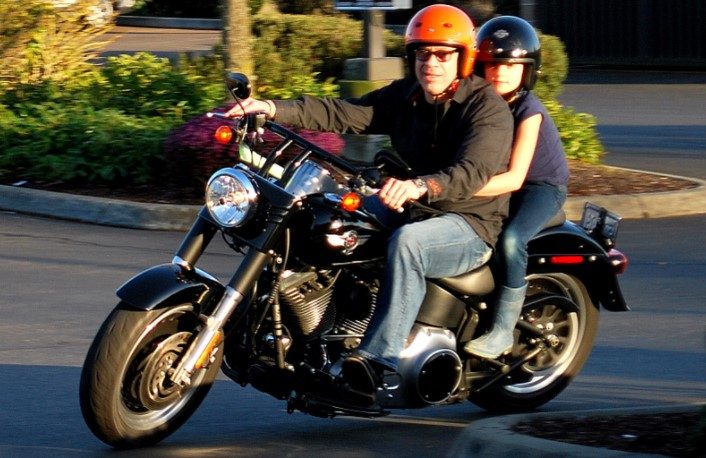
The major problem with having an infant in a car seat on a motorcycle is that they are not strong enough to support their head and neck. If the baby were to fall asleep, it would be hard for them to stay awake and make sure that their neck was supported because of how a car seat works.
Large motorcycles generally have more space than smaller bikes, which allows you to secure a car seat with straps so that your baby will stay in place and secure. You will also want to make sure the straps are tight so that if your baby does fall asleep, the straps will keep them upright and safe.
What About Riding With Older Children?
A child should not ride a motorcycle, but if you must, make sure they are fastened in a car seat, wearing a five-point helmet, and wearing all necessary motorcycle gear.
Tots under one year old should not ride on a bike as they cannot hold their heads up, which could result in injury or death.
Children who can hold their heads up can still be at risk due to other factors such as the helmet not fitting correctly or their feet not reaching the footrests. Children should ride on the back of their bikes until they are tall enough to comfortably rest their feet on the footrests.
It is advised that children be over 12 months (but less than three years) of age before riding with you.
What Should Kids Wear On A Motorcycle?
Helmets
A helmet is the single most important piece of safety equipment you can buy for your child.
The most important thing to do is make sure they’re wearing one at all times. If a helmet is properly fitted, it will sit firmly on your child’s head and remain there even if they fall or crash. Even a minor fall can mean a serious injury without a helmet on, so be sure your child uses one every time they ride.
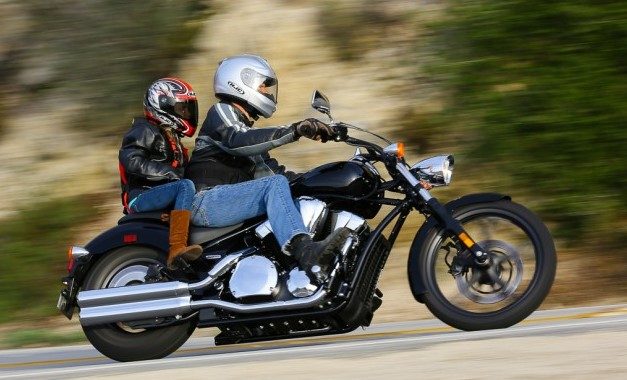
Remember that helmets need to be replaced after any crash, even if nothing seems wrong with them. Also, remember that helmets wear out over time – replace yours every three years at least. The plastic hardens and becomes brittle, and the foam may lose its shock absorbency.
There have been numerous developments in the design of bicycle helmets since they first came out. Many parents don’t realise what to look for when choosing a helmet for their children. The following tips will help you pick a safe helmet that protects your child’s needs.
Before purchasing a helmet, try to make sure that it has the approval of the Consumer Product Safety Commission (CPSC) and the Snell Memorial Foundation. Both organisations test bicycle helmets for safety. Helmets without these certifications may not provide sufficient protection in an accident.
Helmets come in many different sizes, so beforehand, you should measure your child’s head by using a tape measure and comparing sizes with the helmet manufacturer’s size chart. Keep in mind that this measurement is not entirely reliable and may vary from one brand to another, but it will give you a good starting point to work with.
Because children grow so quickly, upgrading your child’s helmet will be tough. Make sure that you try on helmets before buying them to ensure that you get one that fits snugly and comfortably on your child’s head. If it moves or slips around while they are wearing it, they won’t feel safe while riding, or they may try to take it off one day.
Strong boots
Motorcycle boots are the best choice for protecting your child’s feet in this situation. They should be fitted on your child with strong boots that go over the ankle and don’t have laces, which could get caught up in the parts of the bike.
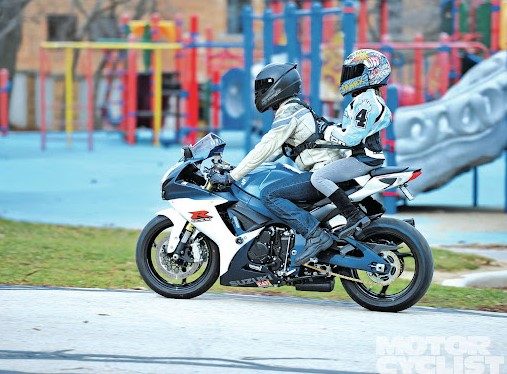
Dirt bike boots come in a variety of styles and colours. Make sure they are made of high-quality materials and offer sturdy foot protection. Also, make sure they are long enough to cover the ankles. You want them long so they can extend past the bottom of the pants or leg protection, which can help prevent injury. The boot should fit snugly around the foot but not too tightly. It should provide support, especially around the ankles and heels, where it will do much of its work protecting the foot from impacts.
Saddle Boots that snap onto the back of a motorcycle saddle are common and provide added protection for a rider’s feet when riding off-road or on trails. These boots can be made either with laces or a drawstring to secure them to the saddle, as well as over-the-ankle protection to help protect them from debris kicked up by the bike’s tires.
Protective clothing
You can find a variety of protective clothing for motorcycle passengers. Many riders wear thick leather jackets, gloves and boots when riding.
An alternative option is a special leather jacket made specifically for motorcycle passengers. These jackets are designed to give your child enough protection without being so bulky that they can’t hold on to the bike. Protective clothing for motorcycle passengers can also include a harness that attaches your child to the bike’s seat. This keeps them in place if the driver breaks or swerves suddenly.
While a costly motorcycle jacket is generally unnecessary, a strong denim or leather jacket will keep your youngster safe. Thick denim is also necessary. Finally, your youngster should be dressed in a pair of thick, protective gloves. Depending on their age, you may wish to use a harness to tie your kid to the seat. It’s risky to rely on a youngster throughout a ride since they can get distracted or sleepy and lose their grasp. You may purchase a specifically made belt with loops for a youngster to grab onto if your child is old enough to hold on on their own. This provides them with a greater grasp and something to hold.
What Is The Safest Way To Ride A Motorcycle With A Passenger?
Riding with a passenger is a great experience, but it requires more than riding alone. Before allowing a passenger to hang on your bike, give them some basic riding instructions. You want to make sure that the person knows how fast you are going, how you are breaking, and how you will stop or turn. Also, it is important to give the passenger a few minutes of practice following you and stopping before setting off on a long journey. This way, your passenger will be familiar with how your bike handles and know how to react in case of an emergency.
- Motorcycles are smaller than cars, so it can be hard for the rider to control both the bike and the passenger. Passengers should always sit behind the driver because if there were to be an accident, they would most likely fall onto the driver instead of in front of them.
- Even if your passenger seems very familiar with motorbikes, it is still important to have safety precautions in place in case something goes wrong.
- The passenger should be sitting as far forward on the seat as possible, with their hands near the rider’s shoulders.
- The passenger should be looking ahead and have a secure place to rest their hands.
- When you first put a passenger on the back of your bike, you may be surprised by how much it affects your bike’s handling. The extra weight will change the way the bike accelerates and brakes. You’ll also find that the motorcycle sags more in the suspension, making turns feel strange as the bike doesn’t lean as much.
- Trying to compensate for these changes can lead to problems. It’s better to understand how they affect your bike and then adjust accordingly.
- If you’re taking a long trip, there are some additional steps you may want to take:
- The extra weight changes the motorcycle handles, making it more difficult to manoeuvre and stop. There are also unique threats that only arise when carrying another person: the risk of them being pulled off the bike due to air resistance, for example.
- Know your limits before you go for a ride with a passenger. It would help if you were comfortable with your gear and your motorcycle so that you have time to focus on operating safely in every situation.
- Avoid carrying passengers until you have completed some solo tours of your local area. Familiarising yourself with all aspects of riding by yourself will help ensure the safety of both you and your passenger if you decide to take them along.
- Practice communicating your movements as a team. Consider practising in an empty parking lot or closed-off area first until you are more confident.
Bottom Line
The bottom line is motorcycles, and car seats don’t mix very well. Child seats can be put on motorcycles. However, it is not the safest way to transport children around town. There is no doubt that motorcyclists are becoming better and safer drivers, but there are other completely uncontrollable risks—pedestrians and cars, for example.
